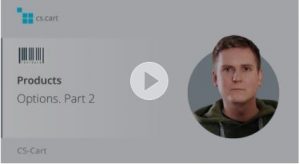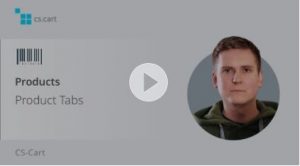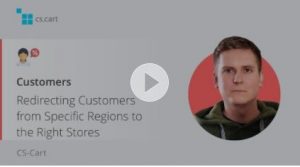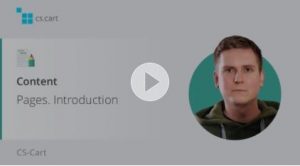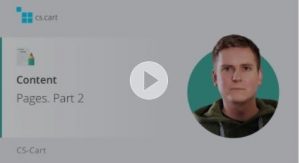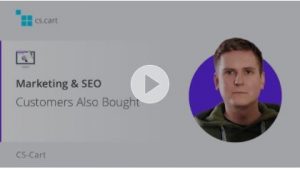Introductie video (Dutch spoken)
Wat leer je tijdens de cursus in 5 minuten uitgelegd
CS-Cart Video Tutorials
The CS-Cart shopping cart software has more than 500 eCommerce features. All the features are logically arranged and easy to use, but it still can take you time to get to know them all by yourself.
In this section, we’ve collected the most important video tutorials related to the CS-Cart software solution. With Alex, your personal teacher, it won’t take you much time to get familiar with the CS-Cart program!
This is the first part of the CS-Cart Appearance Settings Guide. Appearance is not just the way you web store looks like but how convenient it is. That’s why appearance settings in CS-Cart ecommerce shop software change not only the storefront but the Admin panel, too. In this video we speak about appearance settings of the admin panel.

This is the second part of the CS-Cart Appearance Settings Guide. Appearance settings determine how user-friendly your ecommerce storefront can be. If the storefront is convenient and everything is at hand, then online customers would be more likely to buy something from your web shop. In this video we speak about appearance settings of the storefront.

This is the third and final part of the CS-Cart Appearance Settings Guide. Appearance settings include a number of settings to organize product lists on an online storefront. Using them you can create a unique layout for products on the storefront. There is also a common settings section related to date and time format, notifications, and specifically Email templates mode that defines the look of emails and documents in the internet store.

In the CS-Cart web store builder checkout process can be tweaked in any possible way. You can disable guest checkouts to make checkout process more rigorous and thorough, or lift all restrictions and accept orders even without shipping and payment methods to be selected. The choice is yours.
Design

This is an overview of design features of the CS-Cart shopping cart application. All design features in CS-Cart software are found under the Design title of the Admin panel. Themes, Layouts, Templates, Email templates, Documents, Menus, Product tabs. All together they create a unique storefront, where Themes determine the outer look, Layouts — the inner structure, Templates — for precise look tweaking, Menus — to organize information into short consistent lists, Product tabs — to organize the information about a product on a product detailed page.
Themes in the CS-Cart online shop system determine the general look of the storefront. It controls both layouts and styles. By changing theme you drastically change the whole look of your web store including its structure. Styles are less invasive, they only change the color, fonts, and other minor look features. Besides that the default Bright theme can adjust to any type of the screen, so customers can easily buy from your internet store on phones, and tablet PCs.
In the CS-Cart shopping cart system layouts serve as a structure for online store pages. Using this tool you control what information and in what way will be presented on the storefront. This video is dedicated to main concepts of layouts: blocks and containers (also called grids). Blocks contain pieces of information like logos, product details, breadcrumbs, etc. While containers are used for a better page zoning. By juggling blocks and containers you can create design that would be the best for you.
In the CS-Cart web store system layouts serve as a structure for ecommerce store pages. Using this tool you control what information and in what way will be presented on the storefront. This time we speak about another main concept of layouts — layout pages. A layout page represents either a certain type of storefront pages, or a specific storefront page like checkout or cart pages. They are completely customizable to create a truly unique look of your web shop.
Menus is a part of the Design section in the CS-Cart shopping cart application. They help to organize different types of content displayed on pages into short consistent lists. By using menus you can provide lots of useful information without occupying too much space on the storefront. This part of the two-part video is about general menu features and menu creation process.
Menus is a part of the Design section in the CS-Cart electronic commerce solution. They help to organize different types of content displayed on pages into short consistent lists. By using menus you can provide lots of useful information without occupying too much space on the storefront. In this part of the two-part video we show how to add a new menu to the storefront through blocks.
Products
This is the first part of a two-part video about categories in the CS-Cart ecommerce shop software. Categories come in handy when you lots of products of different types in your web store. In this video we are going to discuss what categories are used for, what is their structure, and how to manage them.
This is the second part of a two-part video about categories in the CS-Cart shopping cart platform. Categories come in handy when you lots of products of different types in your online store. In this video we are going to speak about category properties. For convenience, properties are grouped under several tabs.
Product List is a general name for all products presented on the Product page in the Admin panel of CS-Cart open source shopping cart software. Though it might seem that this page is just a list there are plenty of things you can do right on it without diving into product details. Learn about them by watching this video.
In this two-part video we are going to overview the general product settings in the CS-Cart ecommerce store system. Filling the general settings is required to start selling the product online. This time we are looking at Information, Options, and Pricing sections of the General tab.
In this two-part video we are going to overview the general product settings in the CS-Cart ecommerce shopping cart system. Filling the general settings is required to start selling the product online. In the second part we discuss Availability and Extra sections of the General tab.
This is another two-part video this time dedicated to options. Product options appear on the product details page on the storefront as selectable or input parameters to the product. In the first part we will take a look at the global product options. Global product options are found at Products → Options. These options are usually can be applied to lots of products in the web shop.
This is another two-part video this time dedicated to options. Product options appear on the product details page on the storefront as selectable or input parameters to the product. In the second part we will discuss local product options and option combinations. Local product options and combinations are managed on the Options tab of the detailed product page in the Admin Panel.

This two-part video is dedicated to features, unique attributes of products in the CS-Cart business e-commerce solution. In the first part of the video we are going to learn how to create a new feature and how to work with features from the Admin Panel.
This two-part video is dedicated to features, unique attributes of products in the CS-Cart complete shopping cart tool. In the second part of the video we are going to explain where and how features can be applied on a storefront.
Today we speak about filters functionality in one of the best web store software — CS-Cart. Filters are a part and parcel of any modern store. Using them online customers quickly find the products that meet specific parameters. The parameters for filters can be either the standard product fields or the extra fields defined in Products → Features.
There is the Product tabs tab in the product settings, it determines what tabs would be used for the selected products in an online shop. Also on this tab you can change the content of tabs created manually on the main Products tabs page located at Design → Product tabs.
In this video we are going to speak about local layouts for separate product pages. As you might remember layouts determine the structure of pages in the web store. Using them you can add a unique touch to certain product pages, and make them stand out among others.
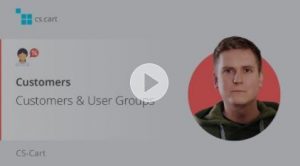
By default the CS-Cart ecommerce platform has the following types of user accounts: Administrators and Customers. This video is about customers and user groups. Customers and user groups are closely related to each other. With user groups you can distribute sale offers, discounts and gifts among online store customers depending on their activity. This way you can award them for being loyal customers and encourage them to buy even more from you.
The CS-Cart shopping cart tool has a very flexible profile fields system which is nice for precise tuning of personal data that your online customers enter during registration or checkout. For example, you can leave contact information fields be available but not required but at the checkout on shipping and billing address step the customer will have to enter full personal data including country, region, city, etc. It is also worth mentioning that without some information post services do not accept orders, for example, zip or postal code.
In the CS-Cart ecommerce platform there is a feature that allows us to redirect online customers from specific regions to a separate web store created for a particular region. For example, there might a separate online shop for visitors from the UK and Canada, and another one for Australia and New Zealand.
Shippings & Payments
Shipping methods in the CS-Cart shopping cart tool are divided by rate calculation into two groups — manual and realtime. Manual calculation rates are set up by administrator and depend on the location, realtime rates are calculated automatically by the post service but require a license from the post service. There are also lots of settings for precise tuning of shipping methods. You can set up additional charges related to the cost of products, their weight and number of items. By the way, in case you work with manual shipping methods, cost dependencies for different regions become the general shipping cost.
Payment methods in the CS-Cart ecommerce application are divided into two groups by processor — offline and online. Offline processors are used to process phone orders, checks and receipts. If you create offline payment method you can choose a template for it. Online processors are used for internet payments and bank transactions. In order to use online processors you will need an account of an online payment service, for example, PayPal or Amazon accounts. Instructions for setting up an online payment method are presented on the configure tab of the selected gateway. There are also lots of settings for precise tuning of payment methods that can be useful in different situations.
Starting with version 4.4.1, CS-Cart software comes with a built-in editor for the templates of email notifications. You can customize these templates according to your needs, or import the templates that were created and exported by someone else. The key features of the new editor are as follows — all notifications are now gathered in one place, easy notification editing, coding skills are not required, preview and test emails features, the Import/Export feature, and much more.
Starting with version 4.4.1, the CS-Cart shopping cart platform comes with a built-in editor for documents, such as invoices, packing slips, and gift certificates. You can customize the documents according to your needs, or import the documents that were created and exported by someone else. The key features of the new editor are as follows — both default and added documents can be edited via the WYSIWYG editor, all documents use one editing system, the content of documents can be managed by including conditions into code snippets, the Import/Export feature, and much more.
This video demonstrates the most important process in the ecommerce store — the process of buying a product and submitting an order. The steps reviewed in this video are as follows — selecting a product, visiting cart page, checkout process, post-order actions and email notifications for online customers and administrators.
This video shows the steps that are made to process the order. From order department notifications about new order to several ways of sending shipments — everything you need to know about handling orders in your web store.
Order statuses may be the most important feature of the order processing and is the easiest way of communication between an administrator and a web shop customer. That’s why this video dedicated solely to the statuses, when they used and how to manage them.
Content
Pages contain general information about your online shop, staff, special promotions, gift certificates, etc. So, it is important to know how to create, group, and manage content in your ecommerce store. This video shows how to create a new page and add it to a storefront.
The next step in managing pages in your online shopping platform is to organize them into consistent structure called page tree. The structure is based on root pages and subpages. Root pages contain other related links under one title, subpages are assigned to root pages to create a structure. Subpages usually serve as content pages while root pages are just a part of table of contents. To place a page tree on a storefront we use layouts and blocks.
After placing a page tree on a storefront there is still few things that you can use to manage web store pages. Add dynamic trees to root pages, or turn them into links to avoid empty pages. Add only the part of a tree that suits the desired page, and don’t display others. Also, you can just disable a block with a page tree on pages where this block is not required.
There are lots of ways to manage languages and translations in the CS-Cart platform. Even in the Admin Panel you can work with two languages at once — one is the interface language, another is the language of content. You can add new translations to your CS-Cart ecommerce tool via multiple sources including Crowdin platform, on-site content editing, and variables translated manually from the Admin Panel.
Marketing & SEO
The comments and reviews add-on once installed can be found in many places of the online store. Store testimonials on the homepage, product ratings and reviews, category reviews if enabled, the feature to start conversations with administrators to discuss order details, and general comments for content pages — all these provided by the Comments and Reviews add-on. Watch this video to learn more about comments and reviews in the CS-Cart ecommerce application.

Promotions allow you to offer various bonuses to your online customers such as free products or discounts, if certain conditions are met. This video shows how customers can receive and apply promotions, what are the basic tools to manage promotions, and how to get to the promotions page on a web storefront.
Promotions are divided into two types — catalog promotions, and cart promotions. This video is dedicated to catalog promotions. Catalog promotions provide only discounts to certain products or categories. For example, all DVDs in the online shop have a 5% discount.
Promotions are divided into two types — catalog promotions, and cart promotions. This video is dedicated to cart promotions and condition groups that help to organize conditions if there is too many of them. Cart promotions allow you to set discounts and offer various bonuses: coupons, free shipping, free products, reward points, membership in a specific user group, etc. The list of possible conditions for those bonuses is bigger. The bonuses aren’t displayed in the catalog, but only on cart and checkout pages of your web shopping platform.
The Abandoned/Live carts section contains the lists of products that your web store visitors added to their carts and wishlists but didn’t purchase for some reason. Carts are saved for both registered and unregistered customers, but for registered customers, the products from the abandoned carts are automatically added to their carts when they visit your ecommerce shop again.
Newsletters is a powerful tool for organizing marketing campaigns. Create mailing lists and autoresponders, gather subscribers, prepare templates, and start sending newsletters to reach potential customers and raise sales. All the mentioned features are included into the Newsletters add-on.
When people don’t know what to buy to their family and friends, they usually buy gift certificates. We will show you how to buy a gift certificate from an online storefront, manage them in the Admin Panel, and activate them to receive gifts.
Banners attract customers’ attention, notify them about offers and discounts. All in all it is a good addition to marketing features. Banners are provided by the Banners management add-on. From this video you will learn how to create banners, place them on an online storefront, and customize banners for separate pages.
Everything you would like to know about Customers Also Bought add-on but were too afraid to ask. The add-on makes it possible to create a special block in your internet shop for the products often purchased along with the current one.
With automatic discount coupons you don’t need to create coupon codes by yourself each time the previous one has been used. It takes two steps to create an automatic discount coupon. First, we create a promotion with discount coupon. Second, we create a promotion that provides coupon codes.













